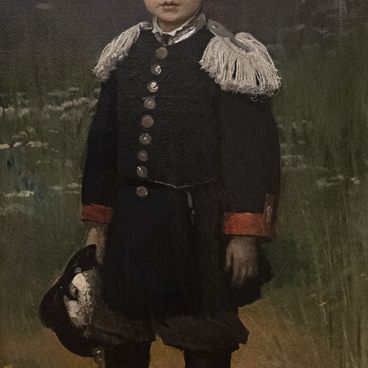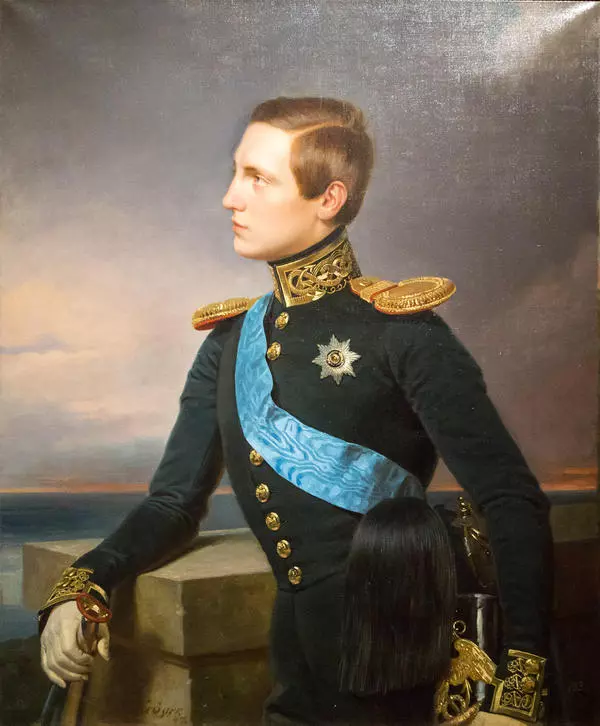The German portrait painter Franz Krüger worked at the Imperial Court of Russia and the Royal Court of Prussia.
Krüger’s first creative endeavors were the drawings of birds for an ornithologist Johann Friedrich Naumann. Then, while studying at the gymnasium in Dessau, Krüger began to paint portraits of the students and teachers, and he also began to take professional lessons from the landscape painter Karl Kolbe the Elder.
In 1812–1814, Krüger studied at the drawing school at the Academy of Arts in Berlin. Fascinated by the depiction of battle and hunting scenes, he left school and took up painting on his own. At the exhibitions of 1818–1820, his works attracted the attention of the contemporaries, and the large equestrian portraits of the Prussian Prince Augustus and of Count von Gneisenau made Krüger a famous master of the portrait genre.
From 1824 to 1833, Krüger took commissions. During this time he painted 18 drawings of the members of the royal house, which the artist presented as a gift to Frederick William III, the painting “Parade in Berlin”, commissioned by the Grand Duke Nikolai Pavlovich, as well as “Portrait of Friedrich Wilhelm III” and “Portrait of Alexander I”, which Kruger executed for the Military Gallery of the Winter Palace in St. Petersburg.
For a long time, the Rostov Museum has been housing one of the paintings by Franz Krüger — “Portrait of a Soldier”. To establish the identity of the model, the museum staff carried out extensive research. As a result, it turned out that Krüger portrayed Karl Merder, a major general and adjutant general, educator of Emperor Alexander II.
The composition of the portrait is typical for the 19th century: the artist depicted Merder, dressed in a military uniform, half-length. A solemn posture and a serious, even stern face expression make the image a solemn variant of a classic ceremonial portrait. The body posture and the look that are slightly turned aside emphasize the thoughtfulness of the model — this is how Krüger sought to show that Merder was not posing, but was rather depicted in a natural pose.
Karl Merder began his military career in 1804 as a cornet. In 1805, he fought at Austerlitz, where he saved his commander by protecting him with his body. In 1808, the health issues resulting from his combat injuries forced him to leave military service and move to a staff position.
Merder taught at the School of Guards Ensigns and Cavalry Junkers, and in 1824, Emperor Alexander I chose him as a mentor for Tsesarevich Alexander Nikolaevich.
Krüger’s first creative endeavors were the drawings of birds for an ornithologist Johann Friedrich Naumann. Then, while studying at the gymnasium in Dessau, Krüger began to paint portraits of the students and teachers, and he also began to take professional lessons from the landscape painter Karl Kolbe the Elder.
In 1812–1814, Krüger studied at the drawing school at the Academy of Arts in Berlin. Fascinated by the depiction of battle and hunting scenes, he left school and took up painting on his own. At the exhibitions of 1818–1820, his works attracted the attention of the contemporaries, and the large equestrian portraits of the Prussian Prince Augustus and of Count von Gneisenau made Krüger a famous master of the portrait genre.
From 1824 to 1833, Krüger took commissions. During this time he painted 18 drawings of the members of the royal house, which the artist presented as a gift to Frederick William III, the painting “Parade in Berlin”, commissioned by the Grand Duke Nikolai Pavlovich, as well as “Portrait of Friedrich Wilhelm III” and “Portrait of Alexander I”, which Kruger executed for the Military Gallery of the Winter Palace in St. Petersburg.
For a long time, the Rostov Museum has been housing one of the paintings by Franz Krüger — “Portrait of a Soldier”. To establish the identity of the model, the museum staff carried out extensive research. As a result, it turned out that Krüger portrayed Karl Merder, a major general and adjutant general, educator of Emperor Alexander II.
The composition of the portrait is typical for the 19th century: the artist depicted Merder, dressed in a military uniform, half-length. A solemn posture and a serious, even stern face expression make the image a solemn variant of a classic ceremonial portrait. The body posture and the look that are slightly turned aside emphasize the thoughtfulness of the model — this is how Krüger sought to show that Merder was not posing, but was rather depicted in a natural pose.
Karl Merder began his military career in 1804 as a cornet. In 1805, he fought at Austerlitz, where he saved his commander by protecting him with his body. In 1808, the health issues resulting from his combat injuries forced him to leave military service and move to a staff position.
Merder taught at the School of Guards Ensigns and Cavalry Junkers, and in 1824, Emperor Alexander I chose him as a mentor for Tsesarevich Alexander Nikolaevich.








